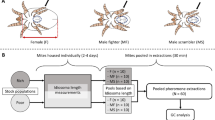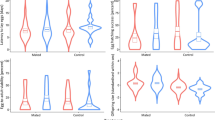Abstract.
We investigated the influence of mating frequency on lifetime reproductive success in females of the bulb mite, Rhizoglyphus robini. This species is highly promiscuous, and its colonial lifestyle promotes mating frequencies of at least several times a day. We manipulated mating frequencies either by keeping females continuously in the presence of a male, with males replaced every second day, or by exposing females to a new male for 4 h every second day (4 h is enough for a male to complete at least one copulation). We used males that were isolated from females either for 2 days, and thus had large reserves of sperm and seminal fluid, or for 2 h. We found that females with continuous access to a male had lower lifetime egg output than those exposed to males intermittently. This effect was mediated through decreased fecundity and not longevity. Male mating history had no significant effect on female fecundity or longevity. These results confirm that mating frequencies observed in bulb mite colonies exceed those necessary for sperm replenishment, and suggests that frequent mating is costly to females. We discuss possible explanations for the maintenance of mating frequencies that are detrimental to females.
Similar content being viewed by others
Author information
Authors and Affiliations
Additional information
Electronic Publication
Rights and permissions
About this article
Cite this article
Kołodziejczyk, M., Radwan, J. The effect of mating frequency on female lifetime fecundity in the bulb mite, Rhizoglyphus robini (Acari: Acaridae). Behav Ecol Sociobiol 53, 110–115 (2003). https://doi.org/10.1007/s00265-002-0557-0
Received:
Revised:
Accepted:
Issue Date:
DOI: https://doi.org/10.1007/s00265-002-0557-0




